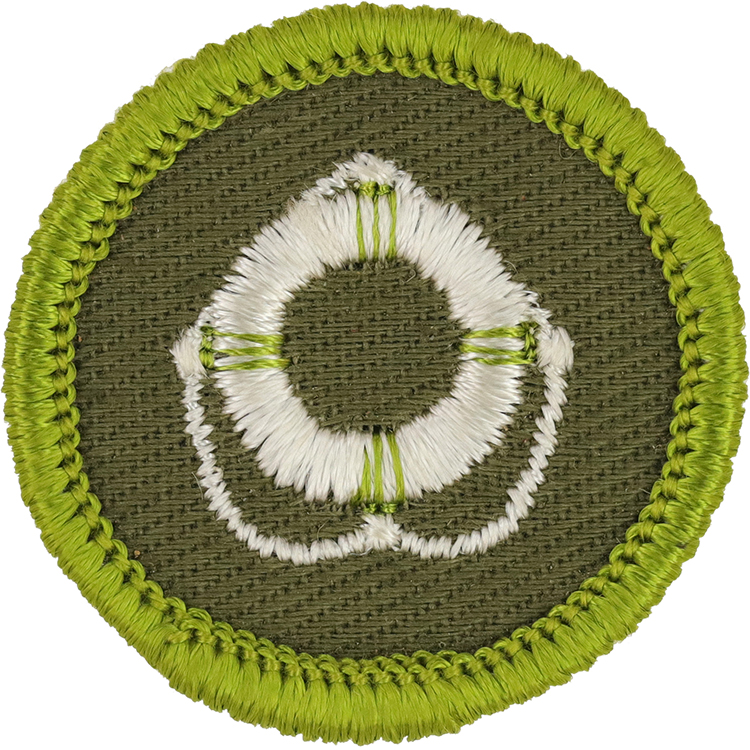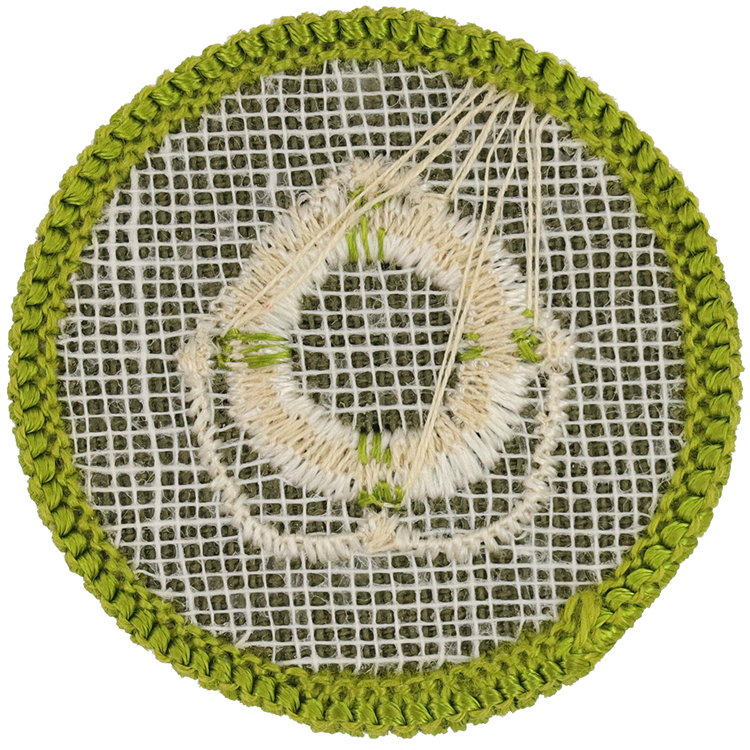
Fig. 1: Lifesa-F-Front
- Cloth: Green right twill
- Border: Merrowed

Fig. 2: Lifesa-F-Reverse
- Back: Gauze reinforced starched
Item Name: Lifesaving 1961 - 1968
Item ID: Lifesa-F
Collector Rating: 1
Requirements June 1953 until January 1960
These tests must be performed before a counselor who holds the senior lifesaving certificate of one of the following organizations: American Red Cross, National Collegiate Athletic Association, Y.M.C.A., or who holds an aquatic school certificate of the Boy Scouts of America for lifesaving.
To obtain this merit badge, you must first have met the merit badge requirements for Swimming, must have spent at least six hours in preparation and practice, and must demonstrate the following:
1. Demonstrate twice your ability to remove street clothes (except underpants or bathing trunks) in 20 seconds or less.
2. Demonstrate correct approach to drowning person who are in the following positions: (a) back to you-back approach; (b) face to you with head above water-underwater approach.
3. With the aid of a buddy and a subject, demonstrate the following rope rescue both as line tender and as rescuer:
As rescuer-Carrying the looped end of 50 feet of 1/8-inch rope across shoulder and chest, enter water with run or jump, swim 50 feet to struggling person whom you grasp with one hand, grasp with other hand, and be towed ashore.
As line tender-Chain knot rescue line. Tie and place loop around rescuer's shoulder, pay out rope, and pull rescuer and subject ashore.
4. Watching struggling person constantly, enter water feet first (by jumping or running) and-(a) swim 30 feet, make correct approach, and tow victim 30 feet to shore with hair carry; (b) swim 30 feet, make correct approach, and tow victim 30 feet to shore with cross chest carry.
5. Swim 30 feet, make correct approach to a tired person and, using tired swimmer's carry, push 30 feet to shore.
6. In water at least 6 feet deep, demonstrate how to block effectively and avoid by ducking the following grips of a struggling person: around neck with right arm, with left arm, with both arms. In each case, turn struggling person around and place him in a position for towing ashore.
7. Demonstrate ability to perform artificial respiration.*
8. Surface dive in 6 to 8 feet, recovering various objects three times and a 10-pound weight once.
9. In deep water, remove street clothes (except underpants or bathing trunks) and swim 100 yards.
*The most practical method is mouth-to-mouth artificial respiration. Under certain conditions the manual chest-pressure arm-lift or back-pressure arm-lift methods may be used.
Second Class Scouts must first qualify for First Class Scoutcraft Requirement 5 before attempting to meet the requirements.
5. Go Swimming
Swimming*--Tell what precautions must be taken for a safe swim. Jump feet first into water over your head in depth. Swim 50 yards. During the swim, stop, make a sharp turn, level off and resume swimming.
Requirements January 1965 until November 1965
To obtain this merit badge, you must first met the merit badge requirements for Swimming, demonstrated your endurance and stamina by completing a 440-yard swim, and spent at least 6 hours in preparation and practice.
1. Explain:
(a) The Eight Defense plan for safe swimming; (b) the order of methods preferred in lifesaving.
2. Demonstrate reaching rescues involving the use of arms, legs, branches, sticks, towels, shirts, paddles, or poles.
3. Demonstrate rescues using thrown equipment including heaving lines, ring buoys, and free-floating supports such as boat cushions or planks.
4. Demonstrate the use of boats, canoes, paddle boards, or other floating devices in making rescues.
5. With the aid of a buddy and a subject, demonstrate a line rescues, using a 50-foot length of rescue line. If available, a torpedo buoy on a surf line should also be demonstrated.
6. Demonstrate, on two occasions, your ability to remove street clothes*, except underpants or swim trunks, in 20 seconds or less. Explain the importance of disrobing before attempting a swimming rescue.
7. Make a leaping or running entry into the water and demonstrate the correct approach to a drowning person who is in the following position: back to you-rear approach; face to you, head above or below water-front surface approach.
8. Without losing sight of a struggling person, enter the water feet first by jumping or running and (a) swim 30 feet, make the correct approach, and tow the subject 30 feet to shore with a cross chest tow; (b) swim 30 feet, make the correct approach and tow the subject 30 feet to shore with a wrist tow. In each case place the subject on a deck or shore, using the proper lift to carry him from the water.
9. Demonstrate in deep water your defense against grasps by blocking, turning, and placing the subject in position for towing ashore.
10. Swim 30 feet, make the correct approach to a tired swimmer, and move him 30 feet to safety using: (a) foot push, (b) underarm swim-along, and (c) tired swimmer's push (subject on back).
11. Make four surface dives in 6 to 8 feet of water, recovering various objects three times and a 10-pound weight once.
12. Demonstrate underwater search techniques: (a) as a part of a "lost bathers drill" team; and (b) as an independent diver using a mask, fins, and a snorkel (not scuba).
13. While disrobing in the water show how street clothes* can be inflated to provide support using your shirt, trousers, and pockets. Then swim 100 yards.
14. Explain artificial respiration. Demonstrate your ability to apply rescue breathing (mouth-to-mouth or mouth-to-nose method) and a manual method (chest-pressure arm-lift or back-pressure arm-lift).
*Street clothes means low shoes, socks, underwear (or trunks), trousers, belt, long-sleeved shirt or sweater or sweatshirt.
Requirements November 1965 until September 1970
To obtain this merit badge, you must first have met the merit badge requirements for Swimming, demonstrated your endurance and stamina by completing a 440-yard swim, and spent at least 6 hours in preparation and practice:
1. Explain:
(a) The Safe Swim Defense plan for unit swimming.
(b) The order of methods to be followed in lifesaving.
2. Demonstrate reaching rescues involving the use of arms, legs, branches, sticks, towels, shirts, paddles, or poles.
3. Demonstrate rescues using thrown equipment including heaving lines, ring buoys, and free-floating supports such as boat cushions or planks.
4. Demonstrate the use of boats, canoes, paddle boards, or other floating devices in making rescues.
5. With the aid of a buddy and a subject, demonstrate a line rescue both as line tender and as rescuer, using a 50-foot length of rescue line. If available, a torpedo buoy on a surf line should also be demonstrated.
6. Demonstrate, on two occasions, your ability to remove street clothes*, except underpants or swim trunks, in 20 seconds or less. Explain the importance of disrobing before attempting a swimming rescue.
7. Make a leaping or running entry into the water and demonstrate the correct approach to a drowning person who is in the following position: back to you-rear approach; face to you, head above or below water-front surface approach.
8. Without losing sight of a struggling person, enter the water feet first by jumping or running and
(a) Swim 30 feet, make the correct approach, and tow the subject 30 feet to shore with a cross chest tow.
(b) Swim 30 feet, make the correct approach and tow the subject 30 feet to shore with a wrist tow. In each case place the subject on a deck or shore, using the proper lift to carry him from the water.
9. Demonstrate in deep water your defense against grasps by blocking, turning, and placing the subject in position for towing ashore.
10. Swim 30 feet, make the correct approach to a tired swimmer, and move him 30 feet to safety using:
(a) Foot push,
(b) Underarm swim-along, and
(c) Tired swimmer's push (subject on back).
11. Make four surface dives in 6 to 8 feet of water, recovering various objects three times and a 10-pound weight once.
12. Demonstrate underwater search techniques:
(a) As a part of a "lost bathers drill" team.
(b) As an independent diver using a mask, fins, and a snorkel (not scuba)
13. While disrobing in the water show how street clothes* can be inflated to provide support using your shirt, trousers, and pockets. Then swim 100 yards.
14. Explain artificial respiration. Demonstrate your ability to apply rescue breathing (mouth-to-mouth or mouth-to-nose method) and a manual method (chest-pressure arm-lift or back-pressure arm-lift).
*Street clothes means low shoes, socks, underwear (or trunks), trousers, belt, long-sleeved shirt or sweater or sweatshirt.



